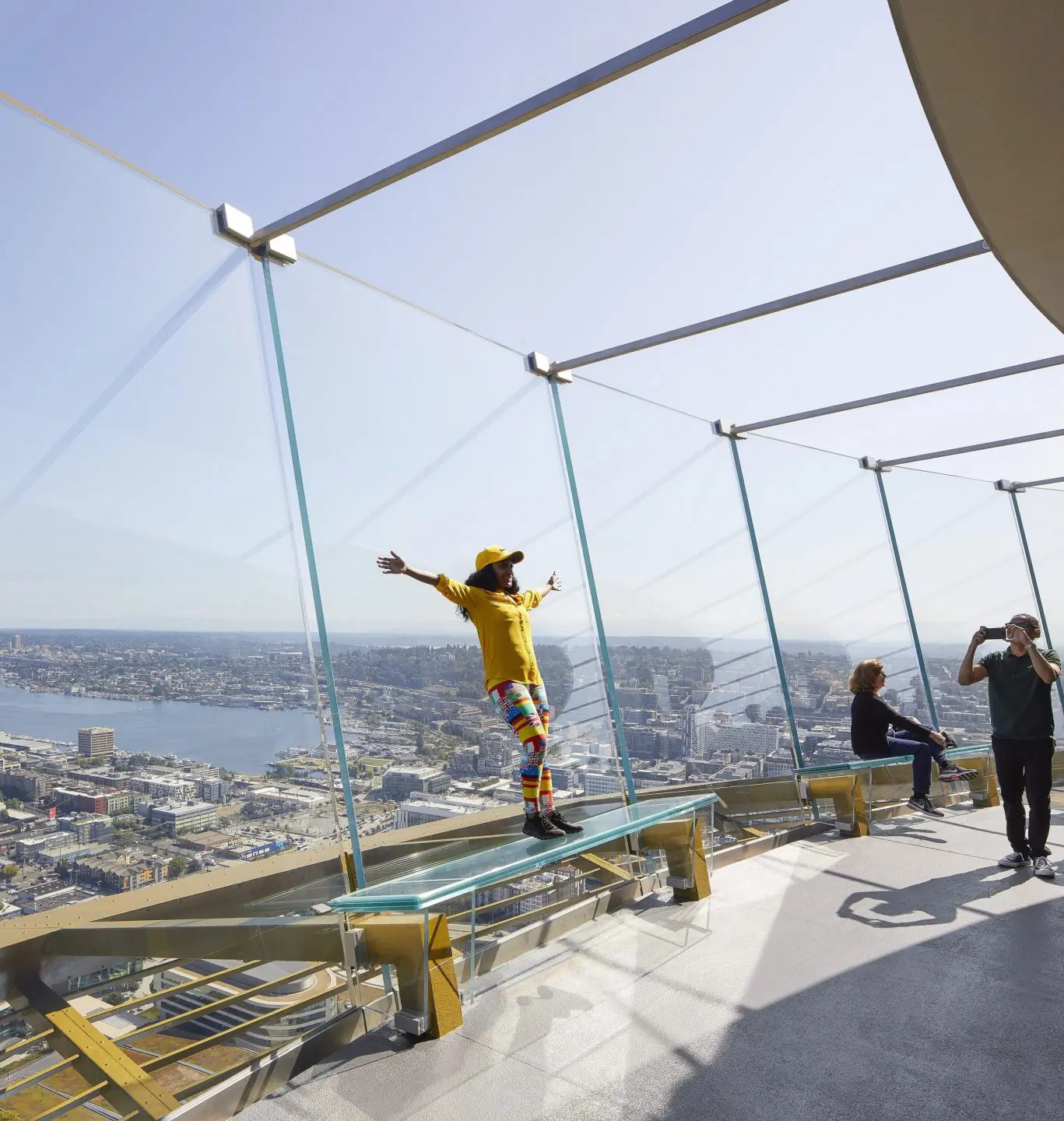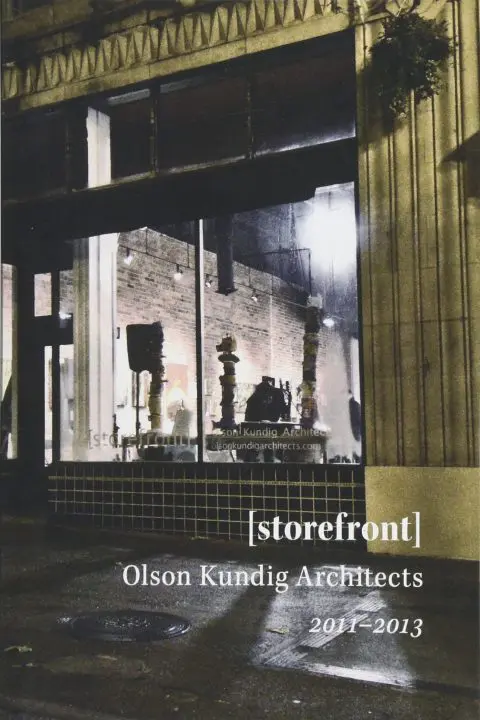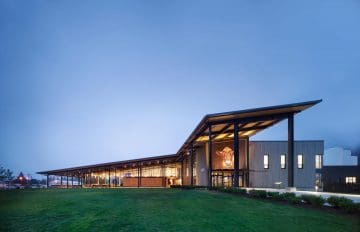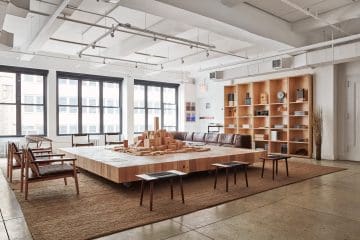For over three decades, Alan Maskin—a principal and owner of Olson Kundig—has designed iconic museums and cultural spaces around the world. His work has resulted in eight national and international design competition wins. Alan’s projects have been widely recognized, including multiple Honor Awards from the American Institute of Architects (AIA), and have contributed to the firm’s reputation as one of the world’s most innovative companies, as recognized by Fast Company and Architizer.

For me, the act of design is deeply mysterious. It's so enigmatic—finding that path to a solution that no one, including you, could have imagined.
Alan Maskin
Principal / Owner
Pursuit of Architecture
Alan credits three prominent women in his life with shaping his architectural trajectory. In the 1960s, his mother introduced him to modern architecture, highlighting works that harmonized with nature in unprecedented ways, evident in his design of three rooftop parks and the “Fifth Facade.” In the 1970s, his Aunt Carol exposed him to NYC’s emerging art scene, where, as a teenager, he discovered the power and autonomy of conceptual ideas. These experiences informed the narrative approach used in the Bob Dylan Center, The City of Loneliness in Korea, and his work with artists in 38 Beams and Underbelly. In the 1980s, studying under Astra Zarina in Rome, he was inspired by ancient urban precedents in modern architecture, and in particular, the ways architects like Carlo Scarpa created inventive ways to react to historical contexts while simultaneously marking the notion of time passing. His designs for the Space Needle and ANOHA reflect his ability to honor past creations while enhancing them using modern tools and technologies.
It was no coincidence that during these early years Alan embraced his identity as a gay man. He found acceptance in these creative communities where differences were often celebrated as strengths. When he joined Olson Kundig in 1992, he found a place that embraced both his creative efforts and his desire to live openly.

Outsized Cultural Impact
Many of Alan’s projects pursue unconventional challenges, designed to have a broad impact on public and community life. As lead designer for The Century Project at the Space Needle, Alan transformed the iconic 1962 World’s Fair observation tower with a $100 million renovation. The project introduced the world’s first only rotating glass floor at a height of five hundred feet and added 200% more glass, expanding views for the tower’s 1.4 million annual visitors. The project received an AIA National Architecture Award for a new type of “observation architecture” while preserving and revealing elements from the original design, as well as the 2030 District Leadership Award for achieving LEED Gold certification.
Diverging from conventional after-life-care options, Alan also led the design of the world’s first human composting facility in collaboration with Recompose. This cost-effective project repurposed an industrial hanger into an environment that hosts a new, more sustainable death care alternative, emphasizing the positive environmental impact of composting as a final act. The process reduces carbon dioxide emissions by one metric ton per person and consumes one-eighth of the energy required by traditional burial and cremation.


The Making of Museums
Alan’s first project at Olson Kundig was the Frye Art Museum, a collaborative effort that earned him and his team their first AIA Honor Award. This project also established Alan’s primary career focus: expanding Olson Kundig’s portfolio of cultural projects.
This focus has resulted in built projects across the United States, as well as overseas. At the Jewish Museum of Berlin, Alan led a team through an international design competition for a new children’s museum. ANOHA, the winning design, is housed in a 1960s concrete structure originally built as a wholesale flower market. Here, the wooden “building within a building” uses the existing concrete shell as a thermal buffer to reduce energy demand, while operable windows allow the new museum to be naturally ventilated. The project team worked with an unusual Advisory Panel—comprised of 20 immigrant children who had recently arrived in the community. The group invented the museum name, workshopped exhibits and sculptures with local artists in Berlin, and tested new educational programming. ANOHA has required advance reservations for its sold-out ticketing since opening.


Alan went on to lead the design of the Bob Dylan Center in Tulsa, Oklahoma. This museum, also awarded through an international design competition, chronicles Bob Dylan’s creative trajectory through assets from his personal archive. To build this vision, he worked with a team of archivists, historians, rock stars, visual artists, multiple fabrication companies, a graffiti artist, and interactive designers. The continually evolving exhibits frame a living archive that challenges the perception of a museum as the voice of truth, instead incorporating diverse perspectives and voices to offer different stories on the life and career of Bob Dylan.
Currently, Alan is leading three confidential museum projects: a net-zero museum for an American artist, a waterfront sculpture garden, and the Snoqualmie Model Railroad Museum.

The Bob Dylan Center is the single greatest monument to a single living musician that exists in the museum world.Chris Willman
Variety
Research & Tools
Research is central to every cultural project at Olson Kundig. Alan’s “Fifth Façade” concept investigated the underutilized potential of city rooftops. He delved into the environmental impacts and the historical allure of rooftops, tracing back to the Tower of Babel. This self-directed project ultimately won first place out of 1,500 entries in the world’s largest architectural ideas competition, and informed three rooftop parks in South Korea, as well as a concept for outdoor classrooms at Rice University.
Alan became an architect because of his love of drawing; while he still draws every day, his creative toolkit now includes leading teams of computational designers and digital artists. Presently, he’s collaborating with a team to develop concepts for a retail project in South Korea, using AI models to generate numerous design iterations.
Design for Children
Prior to earning his master’s degree in architecture, Alan was an early childhood educator. Identifying a gap in superior design for children, he established a practice involving young people in the design process. His first seminal project, Noah’s Ark at the Skirball Cultural Center, incorporated interactive elements inspired by children’s drawings. Other notable projects include the Holocaust Center for Education and the Bay Area Discovery Museum, which transformed a WWI military campus into an indoor/outdoor museum.


As a designer, my goal is to get parents to put down their cell phones and play alongside their children. My work is intended to be as interesting, engaging, and compelling to adults as to the very young, and to make play irresistible to all ages.Alan Maskin
Principal / Owner


Collaboration & Community
Alan deeply appreciates the pivotal moment in the design process when clients metaphorically take the pencil from his hand to share their ideas, signaling true collaboration. He works closely with clients, colleagues, various creatives, and unlikely sources to move into the realm of unexpected solutions. Throughout his career, he has developed and refined strategies to work with clients and colleagues that begin with the question, “What can we do together that we cannot do apart?” This question provided the hypothesis for a two-year design experiment, called [storefront]: Olson Kundig, which featured over 21 installations and community events, co-led and curated by Alan and principal/owner Kirsten Ring Murray.
Studio Culture
Alan has helped shape Olson Kundig’s studio environment with a focus on initiatives that support professional and personal growth. He also co-founded the firm’s International Internship Program in 1996, providing paid positions and mentorship to recent graduates. The program, now overseen by a rotating roster of the firm’s design leaders, has hosted nearly 400 interns from over 30 countries and every US state.
Additionally, he established the Speaker Series, a monthly program that invites creators, often outside the realm of architecture, to speak to the firm and provide a new source of inspiration. Curated by an internal team, the series has been active for over thirty years and recent presentations are now available on the firm’s website.

Publications, Podcasts & Lectures
Alan has contributed his projects and perspectives to several books, including New Heights: Transforming Seattle’s Iconic Space Needle, co-authored with Blair Payson and published by Images Publishing in 2024. He also co-edited Arcade: Art Moves, Cities Follow, a design journal on artist migrations, with Kirsten Ring Murray, and supported the development of two volumes self-published by the firm, [Storefront]: Documenta and Kid Stuff.
He is dedicated to continuous learning and inspiration and frequently appears on design podcasts, in addition to lecturing extensively. He has been featured on podcasts including DESIGN:ED, Archinect Sessions, and Monograph, and has lectured at TEDxSausalito, Rice University’s Department of Architecture, the University of Washington’s Department of Landscape Architecture, the ASLA Conference on Landscape Architecture, and the University of Florida, among others. He welcomes opportunities to contribute his knowledge and passion for design and culture to both architects and the broader community.


In a design competition, the client needs to see themselves reflected in the winning idea. You win design competitions with your original ideas, not with your past work.Alan Maskin
Principal / Owner



For me a site is like a found object—it has a past, and the history embedded in a landscape has always fascinated me.Alan Maskin
Principal / Owner



Alan on Play
Visit Play to dig deeper into stories from Olson Kundig projects and people, including recorded interviews, design features, site visits, Speaker Series presentations, and more!
Projects
Lectures & Juries
2024
Horizon House, Presenter
Kurtwood Farms Barntalk, Panel Moderator
2022
Fast Company Innovation Conference, Speaker
Architizer A+ Products, Juror
ASLA Conference on Landscape Architecture, Panel
2021
World Architecture Festival, Keynote Presenter
Facades+ Los Angeles
Bob Dylan Center—VIP Road Show
Education
Master of Architecture, University of Washington
The Architecture in Rome Program, University of Washington, Palazzo Pio, Rome, Italy
Bachelor of Science, Art Education, State University College at Buffalo
Awards
2024
Architectural Digest’s AD100 list, Olson Kundig
Ocean Home Magazine, Top 50 Coastal Architects, Olson Kundig
2023
Architectural Digest’s AD100 list, Olson Kundig
Architizer A+ Awards, Best Large Firm, Olson Kundig
Mountain Living Magazine, Top Architects and Designers List, Olson Kundig
Ocean Home Magazine, Top 50 Coastal Architects, Olson Kundig
AN Interior, Top 50 Architects & Designers, Olson Kundig
Architect’s Newspaper Best of Practice Awards, Honorable Mention, XL West Firm, Olson Kundig
Architizer A+ Awards Winner, Gallery & Exhibition Spaces Category, ANOHA—The Children’s World of the Jewish Museum Berlin
Architizer A+ Awards Finalist, Architecture +Community, ANOHA—The Children’s World of the Jewish Museum Berlin
Chicago Athenaeum American Architecture Award, Bob Dylan Center
Oklahoma Museums Association Awards, Outstanding Exhibit (Columbia Records Gallery), Bob Dylan Center
MUSE Awards Gold Prize – Experiential & Immersive – Exhibition Experience, Bob Dylan Center
2022
Mountain Living, Top Mountain Architects, Olson Kundig
WIN Bronze Medal Winner, Bay Area Discovery Museum (Cultural Venues Category)
Interior Design Best of Year Award, Bob Dylan Center
AIA National Honor Award—Architecture, The Century Project at the Space Needle
2021
Architectural Digest AD100 List, Olson Kundig
AIA Seattle Honor Awards, Award of Merit, ANOHA—The Children’s World of the Jewish Museum Berlin
Interior Design Best of Year Award Winner, Kids’ Zone Category, Bay Area Discovery Museum
2020
AIA Northwest and Pacific Region Design Awards, Honor Award, ANOHA—The Children’s World of the Jewish Museum Berlin
AIA Northwest and Pacific Region Design Awards, Merit Award, The Century Project at the Space Needle
Architect’s Newspaper Best of Design Awards, Honorable Mention, Renovation, The Century Project at the Space Needle
Architectural Digest AD100 List, Olson Kundig
Engineering News-Record National Best of the Best Project Awards, Project of the Year, The Century Project at the Space Needle
Engineering News-Record National Best of the Best Project Awards, Renovation/Restoration Best Project, The Century Project at the Space Needle
Engineering News-Record Northwest, Renovation/Restoration Best Project, The Century Project at the Space Needle
Interior Design Best of Year Award Winner, Kids’ Zone Category, ANOHA—The Children’s World of the Jewish Museum Berlin
Interior Design Best of Year Award Winner, Entertainment Category, The Century Project at the Space Needle
Puget Sound Business Journal CRE Leadership Awards, Designer of the Year
2019
Seattle 2030 District Vision Awards, Leadership Award, The Century Project at the Space Needle
SEGD Global Design Awards, Finalist, Tillamook Creamery
2018
AIA Seattle Honor Awards, Honorable Mention, The Century Project at the Space Needle
2016
Fairy Tales: Architecture Storytelling Competition, The 5th Facade
Architect’s Newspaper Best of Design Awards, The 5th Facade
Northwest Film Forum Local Sightings Film Festival, The 5th Facade
Cascadia Art and Music Festival , The 5th Facade
Port Townsend Film Festival, The 5th Facade
2014
Chicago Athenaeum, American Architecture Award, WSU Visitor Center and Microsoft Cybercrime Center
Northwest Design Awards, Microsoft Cybercrime Center
2013
World Architecture Festival, Display Category, Shortlist, Bill & Melinda Gates Foundation Visitor Center
AIA Seattle Honor Awards – Merit Award, [Storefront]
2012
AIA Northwest & Pacific Region Honor Awards, Special Jury Recognition, [Storefront] Olson Kundig




















































